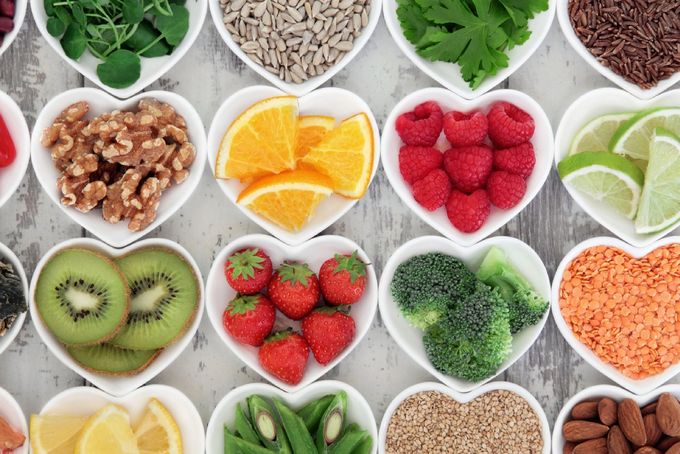Building Blocks of Nutrition: Food Groups for Kids Explained
Watch your child thrive with a balanced diet. Learn about the 5 essential food groups and how they support their growth, development, and overall well-being.
Updated September 30, 2024

Navigating your little one's nutritional needs can feel like decoding a complex puzzle, especially during those vital first years. Whether you're pureeing peas for your baby or chasing a kid who's just discovered the joy of tossing food, understanding food groups can be your compass.
Let's explore the world of nutrition for little ones, where every spoonful counts and every food group plays a starring role in your child's health and development.
» Discover healthy and delicious options from the food groups that will keep your kid satisfied
Understanding the 5 Main Food Groups
A well-balanced diet, including all food groups, is essential for your child's health and development.
1. Fruits and Vegetables: The Nutrient Powerhouses
Fruit and veg are crucial for vitamins, minerals, fiber, and antioxidants. They play a vital role in supporting immune function, promoting healthy digestion, and reducing the risk of chronic diseases later in life.
The vibrant colors often hint at the unique nutrients they contain:
- Dark Leafy Greens: Packed with iron, calcium, and vitamins A, C, and K, these greens are essential for bone health, vision, and blood clotting. Think spinach, kale, and collard greens.
- Cruciferous Vegetables: These powerhouses are rich in fiber, vitamin C, and folate, and contain cancer-fighting compounds known as glucosinolates. [1] Broccoli, cauliflower, and Brussels sprouts are excellent choices.
- Red: Tomatoes and watermelon are packed with lycopene, an antioxidant linked to reduced cancer risk.
- Orange/Yellow: Carrots and sweet potatoes are high in beta-carotene, a precursor to vitamin A that supports eye health. [2]
- Blue/Purple: Berries and eggplant are rich in anthocyanins, antioxidants that may benefit brain function and heart health.
- White: Cauliflower and onions offer allicin, a compound with anti-inflammatory properties.
Aim for your child to eat 5 or more servings of vegetables and fruits each day. [3] A serving is typically 1 cup of raw leafy vegetables, 1/2 cup of other vegetables (cooked or raw), 1 medium fruit, or 1/2 cup of chopped fruit.
» Understand the role of nutrition in immunity
To make fruits and vegetables more appealing to kids, try these tips:
- Offer a variety of options at each meal to expose children to different flavors and textures.
- Include fruits and vegetables in smoothies or sauces to make them more palatable.
- Let your kids be the produce picker at the grocery store or farmers market.
- Start a small vegetable garden together to help kids feel more connected to their food.
- Create fun shapes using cookie cutters and serve with healthy dips like hummus or guacamole.
» Check out the best nutritional shakes for picky eaters
2. Grains: Fueling Growth and Energy
Grains provide carbohydrates for energy, along with B vitamins, minerals, and fiber. They are essential for fueling active, growing bodies and supporting cognitive function. [4] When it comes to grains, whole grains are particularly beneficial for a healthy diet.
» Learn more about protein needs of infants and toddlers
Types of grains to include in your child's diet:
- Whole Grains: Oatmeal, whole wheat pasta, and brown rice offer sustained energy and aid in digestion.
- Ancient Grains: Quinoa, amaranth, and millet provide variety and are often gluten-free.
- Fortified Cereals: These cereals can be excellent sources of additional vitamins and minerals, especially iron and B vitamins.
- Whole-Grain Breads: Look for options with seeds or nuts for added nutrition.
Kids should eat at least half of their grains as whole grains, with portion sizes ranging from 3 to 8 ounces each day, depending on their age. An ounce of grains is about the same as a slice of bread or half a cup of cooked rice, pasta, or cereal.
» Lean how to create a balanced diet for your children
To incorporate a variety of grains into your child's diet:
- Experiment with different grains in salads, soups, and side dishes
- Choose whole-grain cereals with low added sugar
- Use whole-grain flours in baking
- Introduce interesting textures through foods like popcorn or whole-grain crackers
» Find out why nutrition is so important for little ones
3. Proteins: The Building Blocks
Proteins are essential for muscle development, immune function, and overall growth. They also play a crucial role in the production of enzymes and hormones.
While many people associate protein primarily with animal products, there's a wide variety of plant-based foods that can provide all the protein your child needs for optimal health.
Excellent protein sources include:
- Legumes: Beans, lentils, and peas
- Nuts and Seeds: Almonds, walnuts, chia seeds, and flaxseeds
- Soy Products: Tofu, tempeh, and edamame
- Whole Grains: Quinoa, amaranth, and buckwheat
- Lean meats and poultry
- Fish and seafood
- Eggs and dairy products
Children need about 2 to 6.5 ounces of protein each day, depending on their age. An ounce of protein is equivalent to 1/4 cup of cooked beans, 1 tablespoon of peanut butter, or 1/2 ounce of nuts or seeds.
» Discover mineral-rich yummy protein shakes for your little ones
To ensure adequate protein intake:
- Include a protein source at every meal
- Experiment with different protein sources to ensure a variety
- Give kids protein-rich snacks like hummus with vegetables
- Combine different plant proteins like buckwheat and almond to ensure a complete amino acid profile
For picky eaters, try incorporating protein into familiar foods. For example, add pureed white beans to mac and cheese or ground nuts to oatmeal.
» Beat the picky eater phase: Try toddler meal ideas they can’t resist
4. Dairy and Alternatives: Calcium Boosters
Dairy products and their alternatives are important sources of calcium, vitamin D, and protein. These nutrients help build strong bones and teeth and support overall growth and development.
Good sources include:
- Milk—cow's milk or fortified plant-based alternatives like soy, almond, or oat milk
- Yogurt—dairy or plant-based
- Cheese—dairy or plant-based
- Calcium-fortified juices
- Calcium-set tofu
» Try this plant-based formula for a nutritional boost for your little one
To incorporate this food group into your child's diet:
- Use milk or alternatives in smoothies or oatmeal
- Make puddings or overnight oats with milk or fortified alternatives
- Offer yogurt with fruit as a snack
- Include cheese or fortified plant-based cheese alternatives in sandwiches or as toppings for vegetables
It's worth noting that many plant-based alternatives are fortified to match or even exceed the nutrient content of cow's milk. These alternatives can be an excellent choice for children who are lactose intolerant, have dairy allergies, or follow a plant-based diet.
» Nourish your baby's delicate tummy with lactose-free organic formula
5. Healthy Fats: Essential for Brain Development
Fats play a key role in brain development, hormone production, and the absorption of fat-soluble vitamins (A, D, E, and K). It's important to include healthy fats in your child's diet while limiting saturated and trans fats.
Sources of healthy fats include:
- Avocados
- Nuts and seeds—almonds, cashews, sesame seeds, and flaxseeds
- Olive oil and canola oil
- Fatty fish—salmon and sardines
» Understand the importance of omegas 3 and 6 for kids
Tips for incorporating healthy fats:
- Use avocado as a spread or in smoothies
- Sprinkle nuts or seeds on salads or plant-based yogurt
- Use healthy plant-based oils for cooking
- Offer nut butter as a snack with fruit or whole-grain toast
- Add ground flaxseed or chia seeds to oatmeal or baked goods
Nuts, seeds, and avocados not only provide healthy fats but also come packaged with fiber, vitamins, and minerals, making them an excellent choice for growing kids.
» Learn about the best nutritional supplement for kids with failure to thrive
Nutritional Needs at Different Ages
It's important to remember that nutritional needs change as children grow. Here's a brief overview:
Infants (0–12 months)
- 0–6 months: Exclusive breastfeeding or iron-fortified formula is recommended
- 6–12 months: Introduction of solid foods alongside breast milk or formula
- Key Nutrients: Iron, zinc, vitamin D, and DHA (an omega-3 fatty acid)
When introducing solid foods, start with iron-fortified cereals and pureed vegetables and fruits. This is a great time to introduce a variety of flavors and textures.
» Check out these tips for transitioning from breastfeeding
Toddlers (1–3 years)
Toddlers need nutrient-dense foods to meet their nutritional needs. They require approximately 1000–1400 calories per day.
Specific considerations:
- Iron: Crucial for brain development. Look for fortified cereals, beans, and dark leafy greens.
- Calcium: Essential for bone growth; aim for 700mg daily. Include fortified plant milks and leafy greens.
- Vitamin D: Important for calcium absorption. Consider supplements if sunlight exposure is limited.
- Healthy Fats: Vital for brain development. Good sources include avocados, nuts, and seeds.
» Ensure your toddler is nourished with complete nutrition formula
Preschoolers (4–5 years)
At this age, children may experience a decrease in appetite as their growth slows. They require about 1200–1600 calories per day.
Specific considerations:
- Fiber: Introduce more whole grains and vegetables to support digestive health
- Protein: Ensure adequate intake for muscle development—try legumes, nuts, and seeds.
- Limit Added Sugars: Start teaching kids about "sometimes" foods vs. everyday nutritious options
» Check out these tips for feeding your kids
School-Age Kids (6–12 years)
Children at this age experience steady growth and increased activity levels, reflected in their calorie needs of 1600–2200 per day.
Specific considerations:
- Calcium and Vitamin D: Crucial for bone density as children approach puberty. Consider fortified plant milks and leafy greens.
- B Vitamins: Important for energy metabolism. Whole grains and legumes are excellent sources.
- Omega-3 Fatty Acids: Support brain function. Examples include walnuts, flaxseeds, and chia seeds.
- Zinc: Important for immune function and wound healing. Found in whole grains, legumes, and nuts.
» Confused about your baby's vitamin and mineral needs? Learn more in our baby nutrition guide
Balancing Nutrients and Proportions
Creating balanced meals is more than just including foods from each group. It's about providing a variety of nutrients in the right proportions. Here's a general guide to balancing food groups:
- Vegetables and Fruits: Should make up a significant portion of your child's diet, with a slight emphasis on vegetables due to their broader nutrient profile and lower sugar content.
- Grains: Include whole grains in most meals, but balance them with other food groups to avoid excessive calorie intake from carbohydrates alone.
- Proteins: While essential, the amount needed is often overestimated. Try to include a variety of sources to meet your child's requirements.
- Healthy Fats: Essential but should be provided in moderation due to their calorie density.
- Dairy and Alternatives: Include these to ensure adequate intake of calcium, vitamin D, and other key nutrients.
» Discover when to start finger food for babies
A helpful visual guide is the "plate method":
- Half the plate should be filled with fruits and vegetables
- One-quarter with whole grains
- One-quarter with protein sources
- Add a serving of dairy or a fortified alternative on the side
This can be adapted for different meals and snacks throughout the day.
» Support your child's active lifestyle with a convenient and nutritious shakes
The Power of a Varied Diet
A balanced and diverse diet is key to ensuring your child receives all the necessary nutrients for optimal growth and development. Here's why variety is so important:
- Diverse Nutrients: Different foods provide different nutrients. By offering a wide variety of foods from all food groups, you ensure your child gets a broad spectrum of vitamins, minerals, and other beneficial compounds.
- Balanced Fiber Intake: A varied diet naturally includes foods rich in fiber, which aids digestion, promotes feelings of fullness, and supports a healthy gut microbiome.
- Protein Sources: Incorporating diverse protein sources, both animal and plant-based, can significantly contribute to your child's protein needs, often with additional nutritional benefits.
- Micronutrient Variety: Different food groups offer unique micronutrients. For example, dairy provides calcium, while leafy greens offer iron and folate.
- Heart Health: Including a variety of foods from all food groups is associated with better heart health later in life. [5]
- Weight Management: A balanced diet with a variety of nutrient-dense foods can help maintain a healthy weight.
- Nutritional Insurance: By including a wide variety of foods in your child's diet, you're providing nutritional insurance—if they're missing a nutrient from one food, they're likely getting it from another.
» Learn more about introducing whole foods to your baby
To promote variety:
- Introduce new foods regularly
- Experiment with different cuisines
- Involve children in meal planning and preparation
- Offer a "rainbow" of fruits and vegetables throughout the week
- Rotate protein sources, including plant-based options for meat eaters
» Check out these healthy and tasty lunchbox ideas
Creating Healthy Eating Habits
Beyond the nutritional content of foods, how we approach eating as a family can significantly impact kids' relationships with food. Here are some tips to promote healthy eating habits:
- Create a Schedule: Set regular meal and snack times to provide a predictable structure for eating.
- Enjoy Family Meals: Whenever possible, eat together as a family to promote better eating habits and social connections.
- Let Kids Help: Encourage children to participate in meal planning, grocery shopping, and cooking to increase their interest in trying new foods and learn about nutrition.
- Focus on Mindful Eating: Teach kids to pay attention to their hunger and fullness cues and avoid using food as a reward or punishment.
- Be a Role Model: When your child sees you enjoying a variety of nutritious foods, they're more likely to be curious and willing to try them too.
- Educate About Food Sources: Teach your little ones about where their food comes from. Visit farmers' markets, grow a small herb garden, or involve them in cooking to build a connection with their food.
» Uncover how to plan healthy meals for children
Filling In The Gaps
Navigating the complex world of children's nutrition doesn't have to be daunting. By prioritizing variety within the five main food groups, you're well on your way to creating a healthy foundation.
If you notice nutritional gaps, reach for whole food-based options that are delicious, nutritious, and convenient for busy families. Else Nutrition's range of foods is specifically designed to support children's growth and development. They offer essential nutrients and support optimal health without excessive added sugars or artificial ingredients.
Celebrate every small victory, whether it's trying a new food or helping with meal preparation. You're not just feeding your child—you're nurturing their relationship with food and setting the stage for lifelong healthy habits.
» Explore a range of nutritious options from the food groups to keep your kid healthy
The content and advice provided in this article are for informational purposes only and are not a substitute for medical diagnosis, treatment, or advice for specific medical conditions.
Always consult a pediatrician to understand your child's needs. The article expresses the views of the article's editor
References
[1] R. U. Syed et al., “Broccoli: a Multi-Faceted Vegetable for Health: An In-Depth review of its nutritional attributes, antimicrobial abilities, and Anti-inflammatory properties,” Antibiotics, vol. 12, no. 7, p. 1157, Jul. 2023, doi: 10.3390/antibiotics12071157. Available: https://www.ncbi.nlm.nih.gov/pmc/articles/PMC10376324/
[2] T. Grune et al., “Β-Carotene is an important vitamin A source for humans,” Journal of Nutrition, vol. 140, no. 12, pp. 2268S-2285S, Oct. 2010, doi: 10.3945/jn.109.119024. Available: https://www.ncbi.nlm.nih.gov/pmc/articles/PMC3139236/
[3] E. Czarniecka-Skubina, J. Hamulka, and K. Gutkowska, “How Can We Increase the Nutrition-Related Knowledge in Children Aged 7–12 Years: Results of Focus Groups Interviews with Parents—Junior-Edu-Żywienie (JEŻ) Project,” Nutrients, vol. 16, no. 1, p. 129, Dec. 2023, doi: 10.3390/nu16010129.
Available: https://www.ncbi.nlm.nih.gov/pmc/articles/PMC10780913/
[4] “Whole grains,” The Nutrition Source, May 09, 2024. https://nutritionsource.hsph.harvard.edu/what-should-you-eat/whole-grains/
[5] A. Diab, L. N. Dastmalchi, M. Gulati, and E. D. Michos, “A Heart-Healthy Diet for cardiovascular Disease Prevention: Where are we now?,” Vascular Health and Risk Management, vol. Volume 19, pp. 237–253, Apr. 2023, doi: 10.2147/vhrm.s379874. Available: https://www.ncbi.nlm.nih.gov/pmc/articles/PMC10128075/









